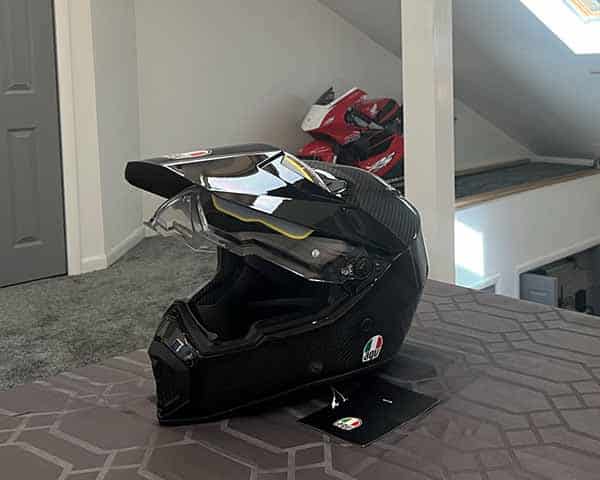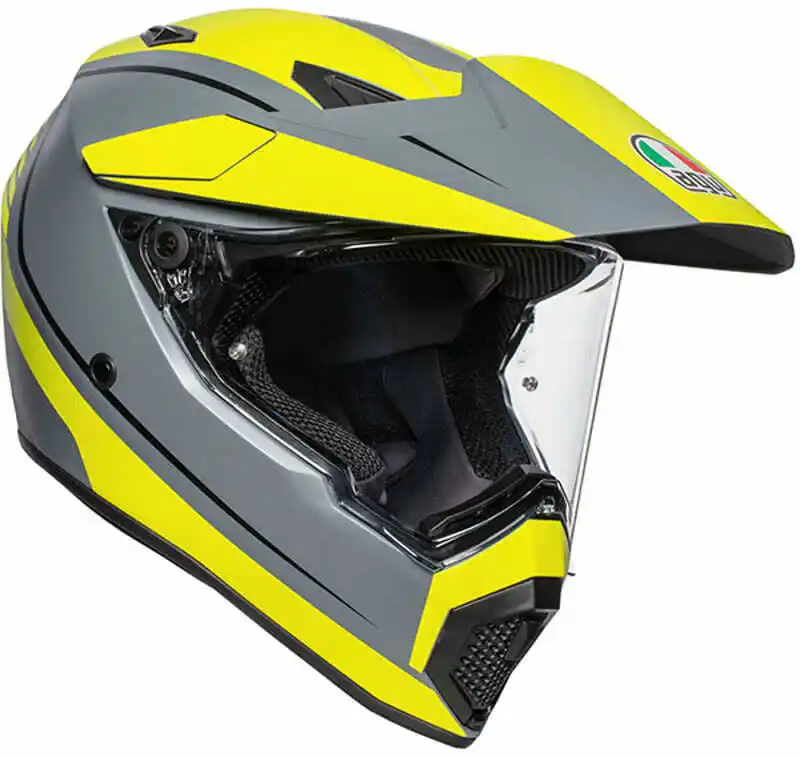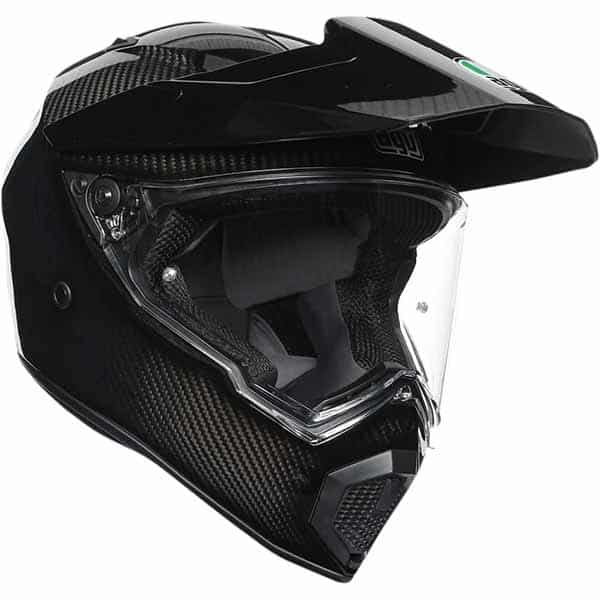Most motorcycle industry experts state how tight a full-face helmet should fit. The helmet should fit snugly around the rider’s head without resulting in any pressure points. The helmet should fit as snug as possible while still being comfortable. A full-face helmet should not be able to move around on the head.
There should not be any side to side or up and down horizontal or vertical movements when the helmet is seated properly on your head. You should not be able to push the chin guard into contact with any part of the front of your face.
The helmet should fit as tightly as possible while still being comfortable. If the helmet has high-pressure points or is just too tight overall, then you have chosen a helmet that is too small. There are also different shaped heads, and some of the helmet manufacturers offer models with different shape liners to fit several head shapes. Examples of this are round, round oval, and long oval liners:
Helmet Name Category Shell Sizes Check & Shop Now
AGV K6 S Best Overall 4: XS-SM, MS, ML-LG, XL-2XL RevZilla | MotoSport | Amazon
HJC RPHA 70 ST Best Sport-Touring 3: XS-S, M-L, XL-2XL RevZilla | MotoSport | Amazon
Schuberth C5 Best Quiet 2: XS-LG, XL-3XL RevZilla | CycleGear | J&P Cycles
Icon Airflite Peacekeeper Most Versatile 3: XS-SM, MD-LG, XL-3XL RevZilla | MotoSport
Klim Krios Pro Best Lightest Adventure 2: XS-M, L-XXXL/3.4 lbs. RevZilla | MotoSport | Amazon
How Snug Should a Full-Face Motorcycle Helmet Fit? How Tight Should Full-Face Helmet Fit?

A full-face helmet should have a comfortable but snug fit all around. The easiest way to check this is by seeing if the helmet moves around on your head or if it can be rotated easily by hand. If the helmet shifts or rotates, it is too loose and unsafe. A loose helmet has a much higher likelihood of coming off in the event of a crash.
However, you do not want to helmet that is so snug that it is tight and gives you a headache or causes any pain or discomfort in any other area, such as the jaw or chin. A helmet that is too tight can be uncomfortable to ride in but a helmet that is to lose can be dangerous or even deadly.
Overall Helmet Fit
Most people focus on whether the helmet is too tight or too loose, but another consideration is how it sits on your head. A properly fitting helmet should sit level on your head with the front edge of the eye ports less than an inch above your eyebrows, so that the foam liner offers protection to the forehead in the event of an impact. It is important when fitting a helmet that you do not have the helmet tilted forward or backwards, and that it is resting level on your head.
Once this is done and the helmet feels snug but not painfully tight. You should be able to confirm that the helmet will not move freely on your head by pushing it with your hand from the back and the front as well as side to side.
Should a Full-Face Helmet Squeeze Your Cheeks?

A full-face helmet should be snug enough that it squeezes your cheeks. It should not be painful or cause you to bite the side of your cheeks, but if it is not squeezing your cheeks firmly then it is for sure, too large too loose. Can you chew gum with your full-face helmet on? If the answer is yes, the helmet is too large.
Is It Normal for a Helmet to Be Tight?
Many new riders make the mistake of thinking a full face helmet is too small because of how tightly it goes onto the head, especially compared to an open-face helmet. Full-face helmets are designed this way, and the next role and cheek pads will always make that entry into the helmet tighter and more compact than when the helmet is fully seated on the head. A good-fitting helmet should be quite snug, especially when new after you wear it for some time, and it will break in some to the shape of your individual head.
Is It Better for a Helmet to Be Too Small or Too Big?
Ideally, you want a helmet that is neither too small nor too big. A helmet that is too small, uncomfortable, but a helmet that is too big can be outright dangerous. It’s always better to air on the side of too snug than too loose. If you can slip your fingers between any part of your head and the helmet, even one finger, then the helmet is too loose, and you need a smaller size.
Can a Tight Helmet Cause a Headache?
Yes, wearing a helmet that is too tight can cause a headache. When the liner and comfort padding are too tight, it is possible to cause an external compression headache, which is caused by pressure over the forehead or scalp. Additionally, depending on the shape of your head a single pressure point, especially in the four-head area or in the temporal area can create discomfort and create a headache.
Do Motorcycle Helmets Loosen Up Over Time?

As a motorcycle helmet is worn and as it ages it will loosen up over time. The amount that a helmet will loosen up depends a lot on the brand of helmet and the price level as the quality of the materials used in the foam padding is the biggest factor in why helmets loosen up over time. The shell will not change, and even the EPS liner will not change very much, either. A few of the pressure points the high spots, if any, may disappear after some time. The main area that will affect the motorcycle helmet loosening overtime is the comfort.
All the various foam materials and fabric used in the comfort patting and liner will tend to compress and age over time, and this will count 95% or more of any loosening. Many of the more expensive new helmets on the market can have the comfort patting replaced. But most riders would just want to buy a new helmet at that point.
Helmets will not loosen up in a few hours or even a few days and not even in a few weeks. Please disregard any information you read that says wearing your helmet around your house for a few hours will break the helmet in, so it is comfortable. Most helmets will loosen up over months of constant use or several months of infrequent use.
How To Fit a Helmet – Measuring
The best way to fit a helmet is to be able to try it on. If you are buying online and do not have that option, then Plan B would be to get a tape measure to calculate the circumference of your head. But be aware that humans have many different shaped heads and that although a tape measure may produce the same numerical measurement on different riders’ heads, they may not all fit properly in the same size helmet.
Additionally, shapes and sizing are very by manufacturer, which is another good reason to try the helmet on the person before purchasing it. You should measure the circumference of your head from about 1 inch above the eyebrows going straight back to the rear part of your head. It is best to take multiple measurements or even have someone else take the measurements for you and again do it several times until you produce the same number consistently.
How To Fit a Helmet – Review of General Tips
The helmet should not go on too easily, it needs to be snug and comfortable when it is seated on your head. But it is preferable that it is a little bit of a squeeze to get it on as the neck role and comfort padding should be quite tight at the opening of the helmet.
The cheek pads should be firmly pressed against your cheeks. The simple, low-tech, effortless way to check this is to see if you can chew gum with your helmet on. If so, it is too loose. It is important that the cheek pads fit very snugly because they are what keep the helmet in the proper position and help keep the helmet from rotating while riding or in the event of a crash.
In no instance should it be possible to remove the helmet if the chin strap is properly secured. If you can pull the helmet off with the chin strap secured, then the helmet is too large and is not safe.
It is always better to try a helmet on, in person, and to buy one online. You already purchased a specific model and brand, and you want another one buying online can define once you are familiar with the shape of your head and the way a particular manufacturer’s helmets fit, but for a first-time purchase, it is difficult to properly fit a helmet by just measuring your head and then purchasing sight unseen online.
Different helmet brands fit in diverse ways and is quite possible that the same size in different helmet brands will fit your head quite differently so it is impossible to say you are a certain size because that may be only correct for specific brands or even models.
The helmet should fit as snuggly as possible without causing discomfort or pain. Over time, you will feel quite comfortable with the added security of a well-fitting helmet. In fact, if you ever put on a loose-fitting helmet, it will feel very strange and awkward.
Your helmet should not be able to move around on your head even if you shake it. It should not slide around and never tilt back or come down over your forehead or move side to side. This is the single most important safety factor when wearing a new helmet.
A helmet that is too loose can come off your head. Even with the chin strap rigidly attached a loose-fitting helmet that is too loose can come off in what is called “roll-off”. If the helmet is loose can move around so much that it can block your vision while you are riding.
How To Fit a Helmet If You Wear Glasses?
Many modern motorcycle helmets have comfort padding designed to accommodate eyeglasses and sunglasses. To be sure about the fit try on your glasses with the helmet before you purchase them.
Michael’s Summary & Conclusion
There is a myriad of factors that a motorcyclist must take into consideration when choosing which full-face motorcycle helmet they will purchase.
- Safety standards
- Comfort
- Weight
- Shell Style
- Peripheral vision
- Face shield mechanism and optics
- Quietness
- Paint and Graphics
- Brand identity
- Secure fit
In my personal experience, the most important point of fit on any motorcycle helmet is the forehead. If my helmet is a little tight and other places, it can be a minor discomfort and may eventually break in. But a pressure point in the four head is likely to cause a headache and can make writing uncomfortable or downright miserable. So, when fitting a helmet, always pay attention to any pressure points on your forehead.
While all these things are important, nothing is more important than to have a helmet with a secure fit. If a helmet rolls off in the event of an accident. It does not matter what standards it meets, or any other factor. They all become quite irrelevant. A secure fit with a Double D style retention system is the single most important safety aspect you should be concerned about.
I've diligently categorized my motorcycle gear recommendations into all available categories, with the aim of providing you with a comprehensive analysis that showcases the absolute best options for all your needs. These items are the culmination of in-depth research, extensive testing, and personal use throughout my vast experience of 50+ years in the world of motorcycling. Besides being a passionate rider, I've held leadership positions and offered consultancy services to reputable companies in over 25 countries. To See Top Picks and the Best Prices & Places to Buy: Click Here!

FAQs — I Have The Answers!
Q: How Tight Should A Helmet Be Fit?
A helmet should fit snugly—not too loose, not too tight—with no side-to-side or up-and-down movements when properly seated on your head.
Q: How Do I Know If My Full Face Helmet Is Too Big?
A helmet that is too big may feel loose, shift excessively, create gaps around your cheeks and forehead, impair your vision, increase wind noise, and lead to discomfort, all of which are signs of an improper fit.
Q: Is It Okay to Wear Tight Helmet?
No, it’s not okay to wear a tight helmet. Tight helmets can exert constant pressure on the head, leading to discomfort and potential health issues in the long run.
Q: How Do You Tighten a Full Face Helmet?
To tighten a full-face helmet, ensure a snug fit by adjusting the chin strap, cheek pads, and helmet liner for optimal safety and comfort.
Q: Should a Full-Face Helmet Be Tight or Loose?
A full-face helmet should be snug but not too tight. It should fit comfortably without causing pressure points or discomfort. A proper fit ensures the helmet provides adequate protection and stays in place during an impact.
Q: How Should a Full-Face Bike Helmet Fit?
A full-face bike helmet should fit snugly around your head with no gaps between the helmet and your skull. The helmet should sit level on your head, covering your forehead and not shifting easily. The cheek pads should make gentle contact with your cheeks, and the chin strap should be snug but comfortable.
Q: Is it Better to Size Up or Down in Helmets?
It’s generally better to choose the size that fits your head measurements accurately. Helmets should not be sized up or down arbitrarily; instead, you should select the size that corresponds to your head circumference as per the manufacturer’s sizing chart. A helmet that is too large or too small can compromise safety and comfort.
Q: How Do You Know Your Helmet Fits Properly?
To ensure a proper fit, the helmet should:
- Sit level on your head and cover your forehead.
- Fit snugly without gaps between your head and the helmet.
- Not move or shift when you shake your head.
- Have the chin strap adjusted so that you can fit one or two fingers between the strap and your chin.
- The cheek pads should press against your cheeks but not cause discomfort.
Information for this article was partially sourced and researched from the following authoritative government, educational, corporate, and non-profit organizations:
MS/M












